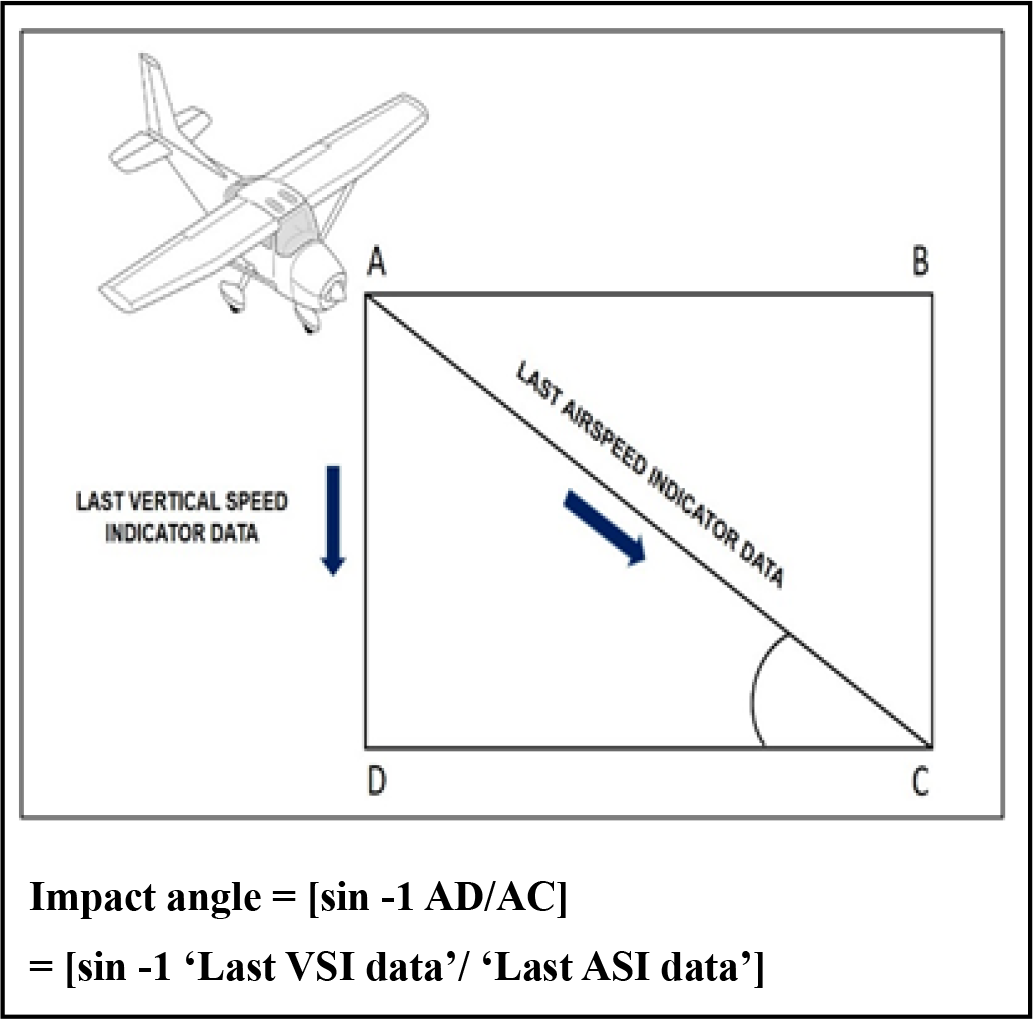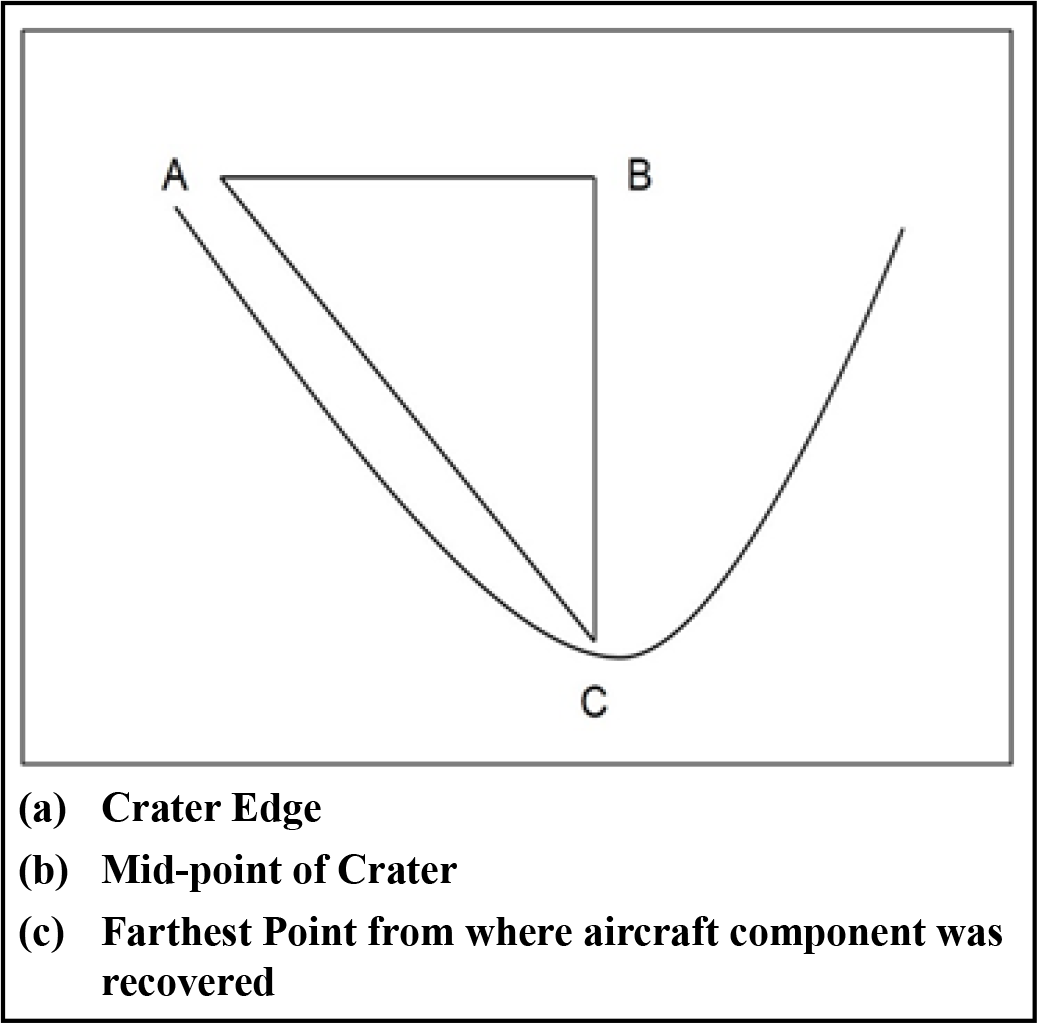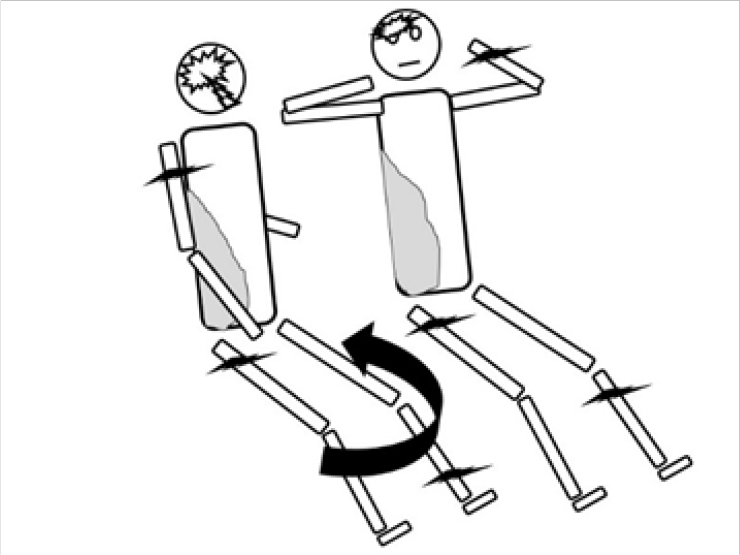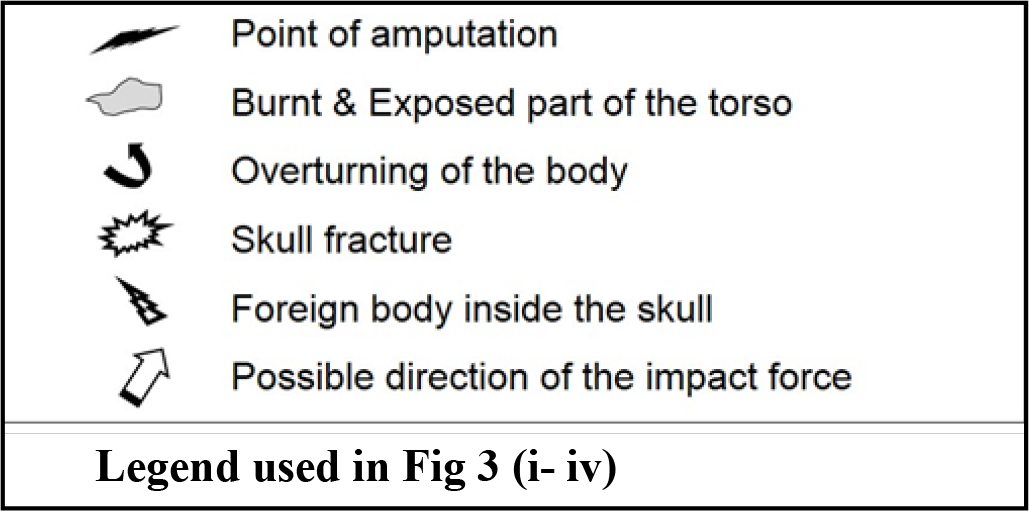Translate this page into:
Injury Pattern Analysis in a Fatal Crash : Unraveling the Enigma
Abstract
Introduction:
Reconstruction of events in pre-crash, during crash and post-crash forms the essence of aircraft accident investigation. In a fatal crash, identification of fatal injuries is important for improving safety measures and eliminating such disasters in future. Depending on the nature of accident, injuries leading to fatality will differ. Hence, injury pattern analysis is a potent tool to identify the epicentre of fatal event and goes a long way in aircraft accident reconstruction & investigation.
Method:
The present study examined the injury pattern in occupants of a light propeller-driven fixed wing, aircraft that crashed, leading to a fatal outcome for both the occupants. Autopsy, post-mortem radiology, photography on site along with aerial recce and assessment of the body position in debris helped in reconstruction of the events. Detailed post-mortem physical examinations of the occupants with respect to various injuries to the soft tissues and the skeletal structures were used to ascertain the kinematics of the crash.
Discussion:
This paper emphasizes the need for detailed injury pattern analysis during post mortem studies of fatal aircraft accidents. It is a useful method to correlate all the factors contributing to an accident.The injuries in this case were produced by transmission of tangential and submaximal deceleration force in right anterolateral direction causing limb amputation and crush injury.The importance of correlating the post-mortem physical and radiological findings with the nature of injuries has been explained.
Conclusion:
Kinematics of the crash can be determined by probable impact angle, calculation of deceleration force, pattern of head injury, visceral injury, extremity injury, pugilistic attitude of the bodies and body position in the aircraft wreckage.
Keywords
Fatal crash
Injury pattern analysis
Aircraft accident reconstruction
INTRODUCTION
‘Aerospace safety’ is the primary concern of aviation industry. Any desynchronization in ‘Man-Machine-Mission’ interface may result in fatal consequences. The main objective of an aircraft accident investigation is to find out the most probable cause of the accident. The investigation of an aircraft accident begins with collection of useful data from the crash site and also from the events of pre-crash and post-crash period. In a fatal crash, useful data can be retrieved in the form of the final positions of the aircraft and its occupants. Autopsy, post-mortem radiology, documentation of injuries with their morphological details and correlating them with circumstantial evidences viz. wreckage distribution etc. are the essence of reconstruction of the accident sequence. Stepwise retrograde analysis from the final outcome to the initial circumstances that initiated the accident is of utmost importance. Injury patterns are of significant value to reconstruct the crash event. The main objective of injury pattern analysis is to establish a possible cause-effect relationship of various factors related to man, machine and mission with the accident. It also helps in evaluating the safety equipment and various aeromedical issues involved in the accident [1]. The evidences drawn from the existing data are used to reconstruct an accident and corrective actions are implemented to prevent similar accidents in future [2].
The present study examined the injury pattern in occupants of a light propeller-driven fixed wing aircraft that crashed on a sandbar shortly after take-off, leading to fatal outcome for both the occupants. The objective of the study was to analyse the pattern of injuries, correlate them with the crash kinematics and ascertain the cause of fatality in a light aircraft accident.
METHODS
In addition to post mortem findings cockpit data (GPS information, airspeed, vertical speed), post-crash state of the airframe, eye-witness’ accounts, examination of photographs of accident site, crater depth-width measurement, victims’ body position in debris, distribution pattern of airframe & human body parts were used for detailed analysis in order to bring out the causal association. Physical examination of the occupants provided the details of various injuries involving both soft tissues and the skeletal structures. These helped in determination of kinematics of the crash. Autopsy, post-mortem radiology were also utilized effectively to understand the internal injuries. Correlating the technical findings with the pattern of injuries sustained by the occupants, a sequence of the events with a possible cause of the fatal outcome was reconstructed. Cockpit voice recorder and flight data recorder couldn’t be used because the aircraft was not equipped with such instruments.
Pattern of head injury, visceral injury, extremity injury, thermal injuries, pugilistic attitude of the bodies and body position in the aircraft wreckage yielded significant information regarding crash dynamics and temperature exposure.
Relevant flight parameters at the final stage of accident as revealed from material evidences viz. ASI, VSI were used to explain the final position of the wreckage. The angle of impact was calculated with the trigonometric approach considering the last recovered data of airspeed and vertical speed (Fig 1). Considering the deceleration as uniform after the impact, stopping distance as well as deceleration magnitude were calculated with the ‘Laws of motion’ (Fig 2).

- Calculation of Angle of impact.

- Calculation of Stopping distance.
Investigation findings
The impact was found to be a shallow approach impact. Deceleration magnitude was found as submaximal but bound to be fatal in the absence of protective equipment. Wreckage didn’t show widespread distribution. The impact formed a crater in which a part of the engine was found buried. Parts of aircraft fuselage viz. flaperon, tailboom were found partially burnt. The occupants were found with pugilistic attitude in their relative position inside the collapsed and burnt cockpit. Seatbelts were found in locked position. Helmets were not retrieved since they were not used in this type of aircraft. Details of injuries of both the occupants have been enumerated below (Table 1 and 2).
| Body parts | Details of Injury |
|---|---|
| Facial tissue | Fully charred, teeth partially charred, tongue charred & protruded. |
| Ears | Fully charred. |
| Lungs | Right lung- External surface partially burnt with carbon particle adhered. Left lung- External surface greyish in colour, spongy & sub-crepitant. No blister, penetrating wound or rupture seen in both the lungs. |
| Ribs | Externally charred with exposed chest muscles. Right lateral portion of rib cage from 4th rib burnt with exposed right lung. |
| Spine | Spinal cord not exposed. Whole spine is grossly normal as evident in the CT scan. |
| Elbow & upper limb | Charred with exposed bones. B/L wrist & palm were burnt & contracted with exposed phalanges. |
| Hip joint | Bilaterally grossly normal. |
| Inner thigh | Burnt, amputated from proximal thigh. |
| Knees | Right knee amputated with thigh. Left knee charred. Bony amputation from proximal left leg. |
| Ankles | Amputed and burnt |
| Other injuries: | (a) Completely burnt-out right lateral aspect of body from thorax to pelvis with exposed internal organs. (b)Left ventricle ruptured near aortic valve. (c)Right lobe of liver is approx. 25% burnt, remaining parts are cooked. (d)Right kidney is missing or burnt. (e)Gall bladder is missing or burnt. (f)Approx. 50% of small & large intestine is missing or burnt. |
| Body Parts | Details of Injury |
|---|---|
| Facial tissue | Fully charred, craniofacial dysjunction with multiple facial & calvarial bone fracture. Fragments of aircraft structure (Fibre part) was found penetrating from face to brain. |
| Ears | Fully charred. |
| Lungs | Right lung- External surface partially burnt with carbon particle adhered. Left lung- External surface greyish in colour, spongy & sub-crepitant. No blister, penetrating wound or rupture seen in both the lungs. |
| Ribs | Externally charred with exposed chest muscles. Right lateral portion of rib cage from 3rd rib burnt with exposed right lung. |
| Spine | Spinal cord not exposed. Whole spine is grossly normal as evident in the CT scan. |
| Elbow &upper limb | Right upper limb amputated or burnt from just below shoulder joint. Left upper limb extensor aspect (Adjacent to the left elbow region) partially burnt with exposed contracted phalanges. |
| Hip joint | Fracture right acetabulum, amputated right lower limb from just below right hip joint. |
| Inner thigh | Charred. |
| Knees | Right knee amputated with thigh. Left knee charred. Bony amputation from distal left leg. |
| Ankles | Amputed and burnt |
| Other injuries: | (a)Completely burnt-out right lateral aspect of body from thorax to pelvis with exposed internal organs. (b)Left ventricle ruptured near aortic valve. (c)Right lobe of liver is approx. 30% burnt, remaining parts are cooked. (d)Right kidney is missing or burnt. (e)Gall bladder is missing or burnt. (f)Approx. 50% of small & large intestine is missing or burnt. |
Post mortem whole body CT scan report of first casualty
Shattered skull with multiple calvarial fractures.
Bony amputation at distal left forearm with detached hand visualized separately.
Right lower limb amputation at the proximal femur level with distal limb not seen.
Bony amputation at the proximal left leg with multiple left lower limb fractures with shattered bony fragments in soft tissues.
Pelvis & whole spine are grossly normal.
Post mortem whole body CT scan report of second casualty
Craniofacial dysjunction with multiple facial fractures.
Multiple bony amputations of extremities in the form of absent right upper & lower limb, left distal leg & foot.
Loss of thoracic cage on the right side.
Fracture right acetabulum.
Spine is grossly normal.
Both the occupants sustained polytrauma and severe thermal injury. Detailed cause of death, discussion on ante-mortem vs post-mortem burn and cause of the accident are beyond the scope of this article to maintain confidentiality.
First victim
The position of the victim in the aircraft debris ruled out likelihood of mid-air disintegration and restraint malfunction. High temperature during the post-crash fire might have produced intracranial steam resulting in a ‘blow out’ fractures of the cranial vault simulating impact injury. This kind of heat could have caused extravasation of blood into the extradural space simulating haemorrhage [3]. Deceleration force (Gx axis) of the magnitude of 45G for a short period and 25G for a long period may not cause any incapacitating injuries [4]. In this crash, the deceleration magnitude was well below this limiting value. Multiple calvarial fracture, lacerated and congested membranes of brain without hematoma were suggestive of submaximal direct impact of the head with the rigid aircraft structure. This event would have been followed with high temperature exposure due to post crash fire. Derived deceleration magnitude supported this evidence. Absence of foreign body in brain tissue ruled out penetration of any aircraft structure into the brain.
Absence of fracture at the base of the skull, absence of any disruption of the sacro-iliac joints or the lumbar transverse processes ruled out the transmission of any potentially injurious force through the spinal column [4]. Absence of definite spinal injury, perineal tear or evisceration suggested less likelihood of ground impact or sudden deceleration along Gz axis or high sink rate.
Ruptured aorta was suggestive of downward displacement of the heart due to compression of the base of the heart between the sternum and the spine. Such kind of injury to the heart may happen when the deceleration force is applied in the vertical (+Gz) direction thus displacing the heart downwards with the aorta anchored. The rupture in this manner usually occurs just above the aortic valve ring or at the end of the thoracic arch just distal to the attachment of the ligamentum arteriosum [3]. Ruptured heart near aortic valve in this case could be explained by sudden shallow angle- tangential deceleration leading to extreme flexion over the seat belt resulting in compression of the heart between the sternum and vertebral column. Clotted blood from thorax might have originated from the ruptured heart.
Both the upper limbs were charred exposing the underlying bones. Bilateral wrist and palm were contracted with exposed phalanges. The pugilistic attitude of the body with thigh flexed at the hips, arms flexed at elbows, wrists laying in front of the body and the fingers hooked-up like claws were suggestive of temperature exposure to the extent of 670°C-810°C for not less than 10 minutes [5]. Since the body was found stiffened, the gradual reduction of thermal intensity and exposure of the body to a prolonged low intensity fire was suspected. Stiffening of a body was due to the coagulation of proteins of the muscles with concurrent dehydration. The flexor muscles being bulkier than extensors contracted more. Symmetrical ‘Boxing or defensive attitude’ could definitely be explained as pugilistic attitude and not related to attempt to activate ‘Parachute rescue system’ of the aircraft. The fire might have continued for around 20 minutes at a temperature of more than 700°C to reach the degree of destruction found on a body viz. complete charring of the scalp and the soft tissues of the face, neck and thorax, protruded intestine through the burnt abdominal wall and charred thigh and knee joints. These findings are supported with the study by B Madea et al. [6].
Amputation of right lower limb from the proximal thigh (Not from articulating surface) was suggestive of a crushing force from the anterior-lateral aspect in the right side. This was followed by high thermal exposure leading to burn injuries. Remains of few fragments of burnt femur and tibia of right lower limb were recovered. Long bones mostly sustained bending injuries while short bones got affected by crushing [3]. A constant fire of several hours was entirely sufficient to destroy the bones to an extent that they crumbled easily either spontaneously or with light to moderate touch [7]. It was quite evident that right lateral aspect of lower extremities had long duration thermal exposure which could be due to toppling of the fuel due to inertia when the fuel tank is exposed to a force from the right-antero-lateral direction. There were no penetrating wound or rupture seen in both lungs that ruled out the penetrating injury caused by any sharp and rigid aircraft structure or fragments. Fractured skull, pattern of amputation of limbs, pelvis and spine which were confirmed by the whole body NCCT support the inference regarding magnitude and direction of the deceleration force.
Second victim
The position of the second victim in the aircraft debris ruled out mid-air disintegration and likelihood of restraint malfunction. This finding was similar to the finding of the first victim. Few fragments of aircraft structure were found penetrating the brain through the face even though there was no decapitation. Cranio-facial disjunction with multiple facial fracture was suggestive of direct impact of head with the rigid aircraft structure.
The direction of pulse force could be ascertained from the anterior aspect. Absence of definite spinal injury, perineal tear or evisceration were suggestive of relatively lesser deceleration force along Gz axis due to the ground impact. Certain findings viz. rupture of heart near aortic valve, clotted blood from thorax were also similar to the findings found in first victim. Amputated right upper limb just below the shoulder joint and amputated right lower limb just below the hip joint suggested the direction of the impact from right antero-lateral aspect.
Recovered bony fragments of the extremities showed thermal exposure like it was found in case of first victim. Loss of thoracic cage integrity in the right side and protrusion of loop of intestine from the burnt abdominal wall supported the inference mentioned above.
Whole body NCCT showed the fractures of right acetabulum, sacrum (left side). However, no injuries were found in the spine. This finding was also suggestive of direct impact force and possibly a torque from the antero-lateral direction. In both the cases, control surface injuries were inconclusive due to partial recovery of remnants of the distal part of the limbs.

- Sitting posture in the cockpit

- Direction of the impact force

- Effect of the impact

- Final position of the victims
Sequence of Events
The sequence of events is depicted in the Fig 3 (i-iv).

- Diagrammatic representation of the impact.
Certain findings in the case of second victim need special consideration. Firstly, despite widespread thermal injury, extensor aspect of left arm and ulnar aspect of left forearm had relatively lesser amount of burn. Secondly, in the starboard side, victim’s body was found in face-down attitude with a direction towards inner-side of the aircraft structure. Main cause of the aircraft-fire was the fuel tank that was situated at the back-side of the seats. Aftermath the impact, fuel presumed to be toppled off to the right antero-lateral aspect due to inertial force and therefore causing more burn injuries to the right side in comparison to the left upper limb which might not be exposed to the fuel. Also, it is also presumed that the fire-retardant overall might have helped in restricting the extension of thermal injuries. Second finding can be explained with the fact that the fragile aircraft structure might have collapsed due to post-crash fire and displacing the body to the inner-side of the aircraft.
DISCUSSION
An injury pattern is simply the enumeration of injuries that a victim sustained during or as a result of a crash and the categorization of injuries by anatomic area or physiologic function [8]. Specific injuries and pattern of injuries pertinent to aircraft accident depend on various factors viz. CREEP (Container, restraint, environment, energy absorption, post-crash) factors, deceleration forces, structural configuration of the aircraft. As far as correlation between injury pattern and the accident is concerned, factors like nature, magnitude and direction of the impact force, time of the injury, injury due to post-crash factors, the artefact by post-crash environment etc. are taken into consideration [8]. In many aircraft accidents the collapsed aircraft structure is responsible for causing injuries including fatality to the occupants [3].
CONCLUSION
Principal cause of death in this case was the combined effect of sudden deceleration and post-crash fire. The injuries were produced by transmission of tangential, shallow, submaximal deceleration force with the direction targeting right anterolateral side of the body causing limb amputation, crush injury followed by a post-crash fire. Detailed analysis of the magnitude, duration & direction of the deceleration forces, cockpit compartment configuration, crash kinematics along with the role of post-crash fire were considered to reconstruct the accident. This paper emphasizes the importance of the detailed injury pattern analysis, which could be used as an appropriate method to determine various contributing factors which lead to a fatal outcome in the event of an aircraft accident.
References
- The value of postmortem examination of passengers in fatal aviation accidents. Aviat Space Enviorn Med. 1980;51:1071-73.
- [Google Scholar]
- The function and purpose of aircraft accident investigation according to the international air law. Mimbar Hukum. 2015;27(2):314-15.
- [Google Scholar]
- Restraint systems and escape from aircraft In: Gradwell DP, Rainford DJ, eds. Ernsting’s Aviation and Space Medicine (5th ed). Florida (USA): CRC Press; 2016. p. :175-87.
- [Google Scholar]
- The degree of destruction of human bodies in relation to the duration of the fire. Forensic Science International. 1998;95(1):11-21.
- [Google Scholar]
- Fire duration and charring a fire corpse [Branddauer und Verkohlungsgrad einer Brandleiche] Arch Kriminol. 1992;189:39-47.
- [Google Scholar]
- The case Beckert (Murder and arson in the German embassy to Santiago de Chile) [Der Fall Beckert (Mord und Brand in der deutschen Gesandschaft zu Santiago de Chile)] Vjschr gerichtl Med. 1910;39:236-305.
- [Google Scholar]
- Aircraft Accidents: Investigation and Prevention. In: Jeffrey RD, Johnson R, Stepanek J, Fogarty JA, eds. Fundamentals of Aerospace Medicine (4th ed). Philadelphia (USA): Lippincott Williams & Wilkins; 2008. p. :596-97.
- [Google Scholar]






